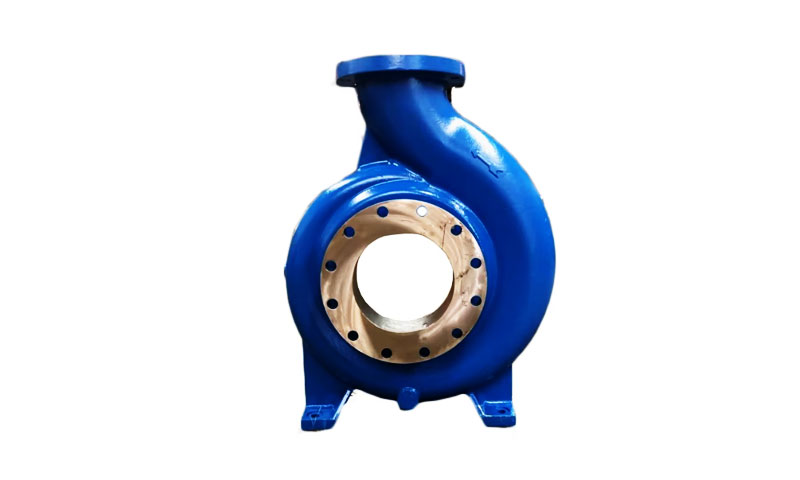1. 導入
Pump bodies are structural and hydraulic housings that convert driver energy into fluid motion. They commonly contain volutes, impeller seats, bearing bosses, flanges and internal passages.
The manufacturing route chosen for a pump body sets achievable geometry, 冶金, cost and lead time.
Investment casting stands out where geometry is complex (internal guide vanes, thin webs, integrated bosses), tolerances are tight, and high-integrity alloys (ステンレス鋼, ニッケル合金, ブロンズ) 必要です.
2. What Is an Investment Casting Pump Body?
Definition and core functionality
an 投資キャスティング pump body is a pump housing produced by the lost-wax (投資) キャスト方法.
A wax (またはポリマー) pattern of the pump body is created, coated in refractory ceramic to build a shell, the wax removed by heating, and molten metal poured into the ceramic mold.
The fired shell is broken away after solidification to reveal a near-net cast pump body that is subsequently finished and inspected.
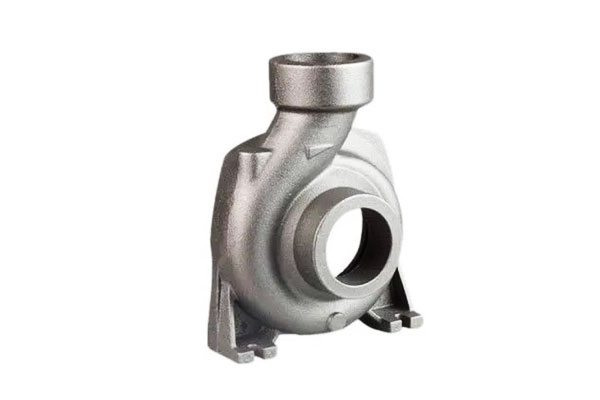
Typical specifications and dimensions
- Part mass: investment cast pump bodies usually range from a few hundred grams to tens of kilograms per piece; many foundries routinely cast pump bodies from ~0.5 kg up to ~50–100 kg depending on plant capability.
- 壁の厚さ: typical nominal walls for stainless or nickel alloys: 3–12 mm; minimum thin sections down to 1–2 mm are achievable in selected alloys and process control.
- 寸法耐性 (as-cast): general investment cast tolerances commonly fall in ±0.1〜0.5 mm for small features; percent-based tolerance of ±0.25–0.5% linear is a practical rule of thumb.
Critical machined features are usually left with machining allowance (0.2–2.0 mm depending on casting accuracy). - 表面仕上げ (as-cast): typical Ra 1.6–3.2μm (50–125分) for standard ceramic shells; fine shells and careful pouring can produce Ra ≈ 0.8–1.6 μm.
Sealing faces or bearing journals are machined/lapped to much finer Ra (≤ 0.2 μm) as required.
3. 設計上の考慮事項
Investment casting enables complex geometry, but good design practice maximizes quality and minimizes cost.
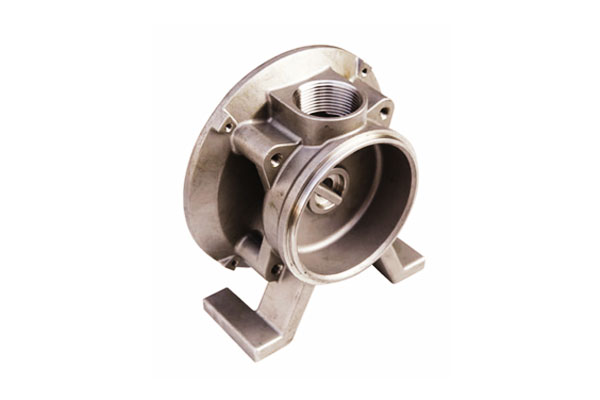
Hydraulic performance requirements
- Flow passages & volutes: smooth fillets and controlled convergence avoid separation and cavitation.
Internal fillet radii should be generous (≥ 1–2× wall thickness) to reduce turbulence. - Impeller seat alignment: concentricity and perpendicularity are critical — plan for machined bores and datum features.
- Clearances: pump clearances at impeller overhangs and seal faces must be maintainable by post-cast machining.
Structural requirements
- Stress & 倦怠感: consider cyclical loads; use finite-element analysis to identify local stress risers.
Cast metallurgy (穀物サイズ, 分離) affects fatigue life—design to avoid thin, highly stressed bosses without proper filleting. - Vibration: stiff webs and ribs help raise natural frequencies; investment casting allows ribs to be integrated into the body.
腐食 & 着る
- 材料の選択: choose alloy based on fluid chemistry (ph, 塩化物, 侵食性微粒子, 温度).
For seawater, duplex or cupronickel may be required; for acids, Hastelloy or appropriate nickel alloys. - Erosion resistance: smooth internal surfaces and sacrificial coatings (ハードフェイス, サーマルスプレー) are options where particulate slurry is present.
寸法公差 & 表面仕上げ
- 重要な機能: designate which faces/bores are finish-machined and specify machining allowances (例えば。, 0.5–1.5 mm for sandier shells, 0.2–0.6 mm for precision shells).
- Sealing surfaces: specify Ra and flatness; often lapped/polished to Ra ≤ 0.2 μm and flatness within 0.01–0.05 mm depending on pressure class.
4. Materials for Investment Casting Pump Bodies
Material selection is a critical factor in designing and producing investment-cast pump bodies, as it directly affects mechanical performance, 耐食性, 製造, そしてサービス生活.
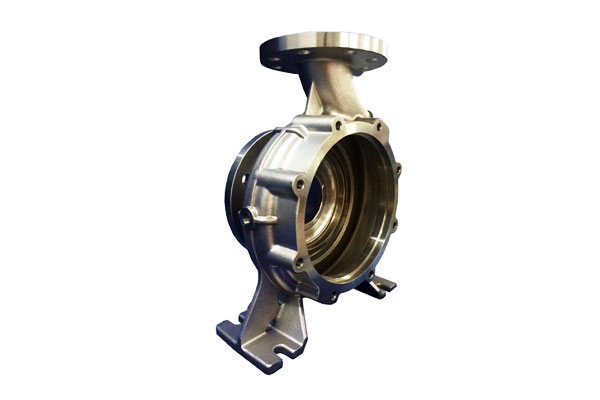
| マテリアルカテゴリ | 例合金 | キープロパティ | 典型的なアプリケーション | 鋳造の考慮事項 |
| オーステナイト ステンレス鋼 | 304, 316l | 優れた腐食抵抗, 中程度の強さ, 良い溶接性; 引張: 480–620 MPa, 収率: 170–300 MPa, 伸長: 40–60% | General chemical pumps, 水処理, 食べ物 & 飲み物 | Good molten fluidity, low hot-cracking risk, easy post-machining |
| デュプレックスステンレス鋼 | 2205, 2507 | 高強度 (Yield 450–550 MPa), superior chloride stress corrosion resistance | Marine and offshore pumps, 積極的な化学環境 | Requires controlled temperature; post-casting heat treatment to prevent sigma phase |
ニッケル合金 |
インコネル 625, 718; ハスロイ | 例外的な腐食抵抗, 高温強度, 酸化抵抗 | 化学処理, 発電, 油 & ガス | High melting points (≈1450–1600 °C); careful mold preheating and controlled pouring needed; difficult machining |
| ブロンズ and Copper Alloys | C93200, C95400 | 優れた海水腐食抵抗, 良い耐摩耗性, antifouling; lower mechanical strength | 海洋ポンプ, 海水冷却, 油圧コンポーネント | Lower melting points (≈1050–1150 °C) simplify casting; low thermal cracking risk; mechanical strength lower than stainless/nickel |
5. Investment Casting Process for Pump Bodies
インベストメント鋳造, とも呼ばれます 紛失したワックスキャスティング, enables the production of pump bodies with complex geometries, 薄い壁, および高次元精度.
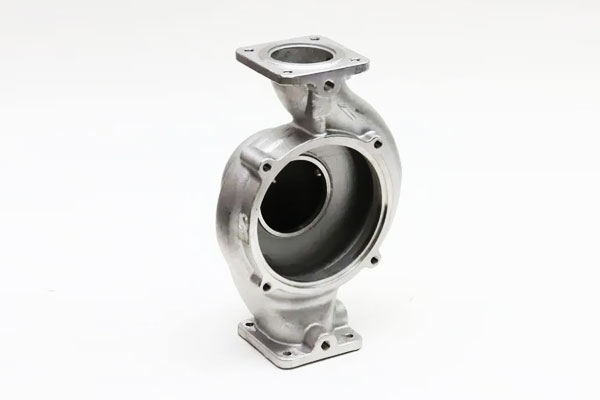
The process consists of several critical steps:
| ステップ | 説明 | 重要な考慮事項 |
| 1. ワックスパターンの作成 | Molten wax is injected into precision molds to form replicas of the pump body. | Ensure uniform wall thickness; maintain dimensional accuracy ±0.1 mm; use high-quality wax to prevent distortion. |
| 2. Assembly of Wax Tree | Individual wax patterns are attached to a central wax sprue to form a tree for batch casting. | Sprue design affects metal flow; minimize turbulence during pouring. |
| 3. セラミックシェルビルディング | Repeated dipping in ceramic slurry and stuccoing with fine refractory sand creates a strong, 耐熱性シェル. | Target shell thickness (5–10 mm) depends on pump body size; avoid cracks and porosity in the shell. |
| 4. Dewaxing and Mold Firing | Wax is melted out (autoclave or kiln), 空洞を離れる; the ceramic shell is then fired to remove residues and strengthen the mold. | Temperature ramping must be controlled to prevent shell cracking; residual wax must be fully removed. |
5. 金属の注入 |
溶融金属 (ステンレス鋼, nickel alloy, またはブロンズ) is poured into the preheated ceramic mold under gravity or vacuum-assisted conditions. | Pouring temperature and rate must ensure complete filling; control turbulence and prevent oxide formation. |
| 6. 固化と冷却 | Metal solidifies inside the mold; cooling rates affect microstructure, 機械的特性, および残留応力. | Thick sections may require controlled cooling to prevent porosity; thin walls must avoid hot tearing. |
| 7. シェル除去 | Ceramic shell is broken away mechanically, often using vibration, sand blasting, or chemical dissolution. | Avoid damaging intricate pump channels or flanges. |
| 8. Finishing and Cleaning | Residual ceramic, gating system, and surface imperfections are removed via grinding, ショットブラスト, or chemical cleaning. | Maintain dimensional tolerances; prepare surfaces for subsequent machining or coating. |
6. キャスティング後の操作
After the pump body is removed from the ceramic shell, several post-casting operations are performed to ensure the component meets functional, 寸法, および表面品質の要件.
These operations are critical for high-performance applications in chemical, 海兵隊, および産業部門.
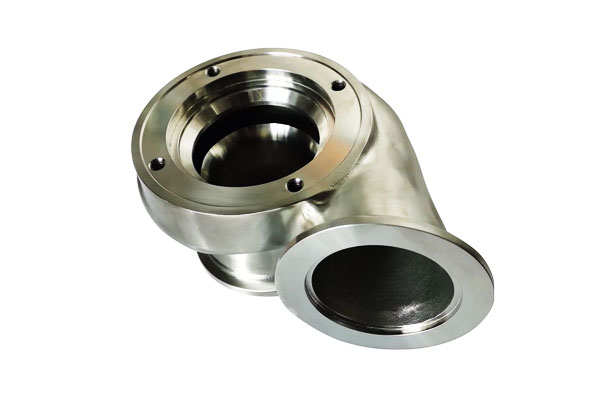
熱処理
熱処理 is applied to relieve residual stresses, 延性を改善します, and optimize mechanical properties:
- ストレス緩和アニーリング: Heating to 550–650 °C for stainless steels reduces residual stress from casting and prevents distortion during machining.
- ソリューションアニーリング: Applied for stainless steels and nickel alloys to homogenize microstructure and dissolve unwanted precipitates, ensuring corrosion resistance and consistent hardness.
- Aging or Precipitation Hardening (for certain alloys): Enhances strength and wear resistance in high-performance materials.
機械加工
Critical dimensions such as flanges, ボア, mating surfaces, and threaded ports are machined to meet tight tolerances.
Typical machining operations include turning, ミリング, 掘削, and boring. Machining ensures:
- Dimensional tolerances of ±0.05–0.1 mm for precise assembly.
- Smooth sealing surfaces to prevent leaks in high-pressure applications.
表面仕上げ
表面仕上げ 耐食性を高めます, 耐摩耗性, と美学:
- 研磨: Improves smoothness for sealing faces and internal channels.
- ショットブラスト: Removes residual ceramic particles and creates a uniform surface for coating or painting.
- コーティング: Optional chemical or electroplated coatings (例えば。, ニッケル, PTFE) enhance corrosion resistance and reduce friction.
非破壊検査 (NDT)
To detect defects such as porosity, ひび割れ, or inclusions, NDT is performed:
- X線撮影 (X線): Identifies internal voids and inclusions.
- 超音波検査 (ut): Detects subsurface flaws in thick sections.
- 染料浸透試験 (pt): Reveals surface cracks and porosity.
Cleaning and Inspection
ついに, pump bodies are cleaned to remove residual machining oils, デブリ, or salts. Dimensional and visual inspections verify compliance with specifications before assembly or shipment.
7. Quality Assurance and Testing
品質保証 (QA) is critical in ensuring that investment casting pump bodies meet design specifications, performance standards, および業界の要件.
A systematic QA approach combines dimensional checks, 機械的テスト, and non-destructive evaluation to detect defects and confirm functional integrity.
寸法検査
Dimensional verification ensures that the pump body conforms to design drawings and tolerances:
- 測定機を調整します (CMM): Measure complex geometries, ボア, フランジ, and mounting surfaces with accuracy of ±0.01–0.05 mm.
- Gauge Tools: Thread gauges, plug gauges, and height gauges verify critical features quickly in production.
- 表面粗さの測定: Confirms finishing requirements for sealing faces and internal channels (例えば。, Ra ≤0.8 μm for hydraulic components).
Mechanical Property Verification
Mechanical testing validates that the material meets required strength, 延性, と硬度:
- 引張試験: Measures yield strength, ultimate tensile strength, と伸び, ensuring the material can withstand operational loads.
- 硬度テスト: Rockwell or Vickers testing confirms that heat treatment and material processing achieved the desired hardness.
- インパクトテスト (必要に応じて): Evaluates toughness for applications exposed to fluctuating loads or shock.
非破壊検査 (NDT)
NDT techniques detect hidden defects without damaging the part:
- X線撮影 (X-ray/CT Scanning): Identifies internal porosity, インクルージョン, and voids, particularly in thick sections.
- 超音波検査 (ut): Detects internal cracks, ボイド, or delaminations in dense materials like stainless steel and nickel alloys.
- 染料浸透試験 (pt): Reveals surface cracks, ピンホール, or fine porosity not visible to the naked eye.
- 磁気粒子試験 (山): Applied for ferromagnetic alloys to detect surface and near-surface discontinuities.
Common Casting Defects and Mitigation Strategies
- 気孔率: Minimized through proper gating, ベント, and controlled solidification rates.
- 収縮キャビティ: Addressed via riser design and thermal management.
- コールドシャットとミス: Avoided by maintaining optimal pouring temperatures and smooth flow in complex geometries.
- Surface Inclusions: Controlled by using high-purity alloys and proper degassing techniques.
8. Advantages of Investment Casting for Pump Bodies
- 複雑なジオメトリ: 内部パッセージ, thin walls and integrated bosses with minimal secondary assembly.
- ネットの形状: reduces material removal vs. rough machining from bar or billet — often 30–70% less machining 複雑な部品の場合.
- 高次元精度 & 表面仕上げ: less secondary finishing for many features compared with sand casting.
- Alloy flexibility: cast many stainless and nickel alloys with good metallurgical integrity.
- Small to medium production flexibility: tooling for wax patterns is relatively inexpensive vs. large die tooling, enabling economic runs from prototypes to thousands of parts.
9. 制限と課題
- Cost for very large parts: above certain sizes (頻繁 >100 kg) investment casting becomes uneconomical compared with sand casting or fabricating/ welding.
- リードタイム: pattern tooling, shell building and firing add lead time—prototype timelines usually measured in weeks.
- Porosity risk in thick sections: thick bosses or large cross-sections require careful gating, chills or segmenting to avoid shrinkage.
- Surface finish and tolerances depend on shell system: achieving ultra-fine finishes or extremely tight as-cast tolerances requires premium ceramic systems and process control.
10. 産業用アプリケーション
Investment casting pump bodies are used across a broad spectrum of industries due to their complex geometry capabilities, 物質的な汎用性, および高次元精度.
The process allows engineers to design optimized hydraulic passages, 薄い壁, and integrated mounting features that improve pump efficiency and longevity.
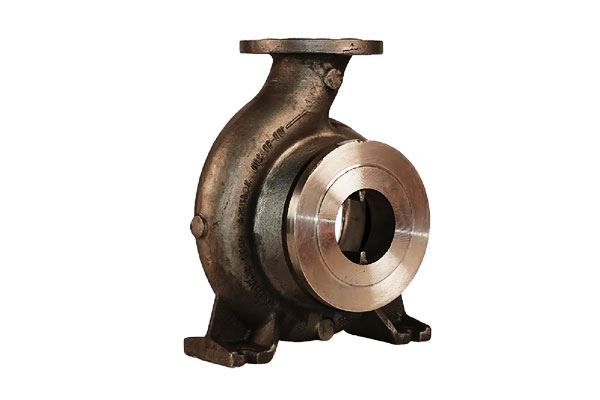
Chemical Processing Pumps
- 環境: Corrosive fluids such as acids, caustics, および溶媒.
- Materials Used: ステンレス鋼 (316l, 二重) and nickel alloys (ハスロイ, インコネル).
- 根拠: Investment casting enables intricate internal channels, minimizing turbulence and ensuring uniform flow, critical for chemical process reliability.
Water and Wastewater Pumps
- 環境: High-volume pumping, abrasive suspended solids, and variable pH levels.
- Materials Used: ブロンズ, デュプレックスステンレス鋼, and corrosion-resistant cast irons.
- 根拠: Thin-wall, smooth internal passages reduce clogging and energy losses, improving efficiency in municipal and industrial water systems.
Marine and Offshore Pumps
- 環境: Saltwater exposure, high-pressure operation, and cyclical mechanical stress.
- Materials Used: 銅合金 (海軍の真鍮, ブロンズ), デュプレックスステンレス鋼.
- 根拠: Resistance to corrosion and biofouling is critical; investment casting allows seamless, complex geometries to reduce maintenance and improve service life.
油 & Gas and Power Generation Pumps
- 環境: 高温, high-pressure fluids, and hydrocarbon-based media.
- Materials Used: High-nickel alloys (インコネル, ハスロイ), ステンレス鋼, and cobalt-based alloys.
- 根拠: Investment casting supports high-strength materials and precise tolerances necessary for critical applications such as turbine lubrication, chemical injection, and offshore drilling.
Specialty and Custom Pumps
- 環境: Laboratory, 医薬品, or food processing applications requiring hygienic and precision performance.
- Materials Used: ステンレス鋼 (304, 316l), チタン, またはニッケル合金.
- 根拠: 滑らかな表面, 厳しい公差, and complex geometries achieved by investment casting ensure minimal contamination risk and compliance with regulatory standards.
11. 比較分析
| 特徴 / 基準 | インベストメント鋳造 | 砂鋳造 | Machining from Solid |
| 幾何学的な複雑さ | Excellent – thin walls, 内部チャネル, intricate features achievable | Moderate – limited by core placement and mold stability | Limited – complex internal geometries often impossible without assembly |
| 寸法精度 | High – ±0.1–0.25 mm typical | Moderate – ±0.5–1.0 mm | Very High – ±0.05 mm achievable |
| 表面仕上げ (ra) | Fine – 1.6–3.2 μm typical; can be polished | Rough – 6–12 μm; requires machining for precision | Excellent – 0.8–1.6 μm achievable with finishing |
| 材料オプション | Wide – stainless steels, ニッケル合金, ブロンズ, 銅合金 | Wide – iron, 鋼鉄, ブロンズ, アルミニウム | Wide – depends on machinable stock availability |
| バッチサイズ | Low-to-medium – 1–1000+ parts | Medium-to-high – economical for large, 単純な部品 | Low – material waste increases cost for large parts |
| リードタイム | Moderate – wax pattern & shell building required | Short-to-moderate – mold preparation relatively quick | Variable – depends on machining complexity |
材料廃棄物 |
Low – near-net shape reduces scrap | Moderate – gating and risers generate some waste | High – subtractive process creates chips and offcuts |
| 部品ごとのコスト | Moderate-to-high – tooling and process steps increase cost, economical for complex parts | Low-to-moderate – simpler molds, larger parts cheaper | High – extensive machining on large, complex parts is expensive |
| 強さ & 誠実さ | Excellent – dense microstructure, minimal porosity if controlled | Moderate – risk of sand-related inclusions and porosity | Excellent – homogeneous, 鋳造欠陥はありません |
| Post-Processing Required | Often minimal – some machining, 仕上げ | Usually significant – machining and finishing required | Minimal – final finishing for tight tolerances only |
| 典型的なアプリケーション | Pump bodies with thin walls, complex hydraulic channels, 耐食性 | 大きい, simple pump housings or structural components | Custom or prototype pump bodies requiring extreme precision |
12. 結論
Investment casting pump body combines design freedom with metallurgical integrity, making them an excellent choice for many fluid-handling applications—especially where complex internal geometry, exotic alloys or tight tolerances are required.
Success depends on early design for casting, informed material selection, careful process control (注ぐ, shelling, 熱処理), and robust QA/NDT programs.
For critical pump systems—marine, chemical or power generation—investment casting can deliver reliable, economical components when specified and executed correctly.
FAQ
What maximum size of pump body can be investment cast?
Typical shop practice ranges up to ~50–100 kg per part, but the practical maximum depends on foundry capability and economics.
Very large pump bodies are more often produced by sand casting or fabricating/welding.
How much machining allowance should I design into an investment casting?
許可する 0.2–2.0 mm depending on the criticality and shell precision. Specify tighter allowances only where the foundry guarantees precision shells.
Which material is best for seawater pump bodies?
Duplex stainless steels and selected copper-nickel alloys are common choices due to superior chloride pitting resistance and biofouling performance; final selection depends on temperature, velocity and erosion conditions.
What is the typical turnaround time for an investment-cast pump body?
Small production runs typically take 4–8週 from pattern approval to finished parts; single prototypes can be faster with 3D-printed patterns but still require shell firing and melt schedules.
How do I specify acceptance criteria for porosity?
Use industry NDT standards (X線撮影, CT, ut) and define acceptance levels in percent porosity by volume or via reference images.
Critical pressure-retaining pump bodies often require porosity <0.5% by volume and radiographic acceptance per customer standard.
